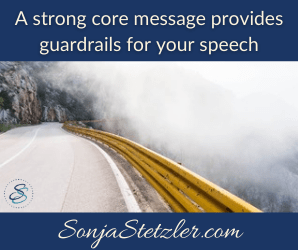Lately, I have been asked by many of my coaching clients if there is a way to make their messages more concise.
In this day and age of virtual presentations, short attention spans, and distractions, getting your point across in as few words as possible and still making an impact is an art. And it’s a skill to develop a concise message.
Effective communication is not necessarily what you say, but what your audience hears. If you beat around the bush or are not succinct enough, your message may get lost in all the noise that surrounds your true message. This is where miscommunication and misinterpretation can come into play.
What’s the answer to a concise message?
Many years ago, I learned a strategy that I teach others to be more concise and succinct when developing your speech content. It’s the third step in my 7-step process of speech development and I recommend it once you are clear about your speech objective (are you conveying information to your audience or are you looking to influence them to take a specific action), and you know what you audience wants, needs, and values.
Crafting a core message.
 The third step is to summarize your whole speech in 10 words. This is how you develop your core message. A well-crafted core message provides a solid foundation on which the rest of your content can be built and expanded. A strong core message provides guardrails for the rest of your speech, as talking points that don’t align with your core message need to be discarded. This also prevents wordy speakers from rambling and losing their audiences.
The third step is to summarize your whole speech in 10 words. This is how you develop your core message. A well-crafted core message provides a solid foundation on which the rest of your content can be built and expanded. A strong core message provides guardrails for the rest of your speech, as talking points that don’t align with your core message need to be discarded. This also prevents wordy speakers from rambling and losing their audiences.
Crafting a strong core message takes practice and it might not come out right the first time you play with this method – and that’s OK. It’s all part of the learning process. For those who master this part of speech development, the rewards are more clarity, conciseness, and a greater understanding by your audience of your message.
